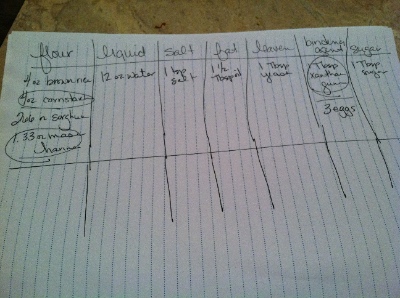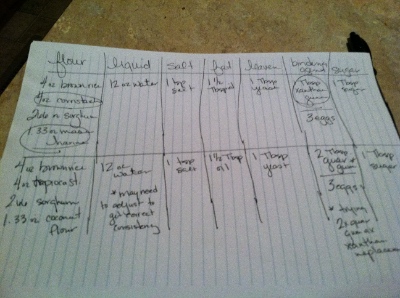In today’s email we’re going to talk about baking bread if you have additional food intolerances besides just gluten – such as to corn, rice, xanthan gum, eggs, or dairy. Most gluten free bread recipes contain one or more of these ingredients, and I often hear from readers who are trying to find a bread recipe that works for their specific situation.
If you have multiple food intolerances then you’re not always going to be able to find the perfect recipe for your dietary needs. But I’m going to show you a strategy for taking a recipe and altering it so that it works for you.
Once you’ve learned this strategy you can use it to make recipe alterations in all sorts of other recipes. Your imagination is the limit =)
Let’s Do Some Exercise!
So let’s get started. You’ll need the following items so that you can do the exercise along with me..
* Piece of paper
* Pen or pencil
* A Gluten Free Sandwich Bread. You can use mine, or if you’ve found another GF bread recipe that is closer to meeting your dietary requirements, feel free to use that one.
* You’ll also need your notes from the flour mix exercise where you listed the various components of gluten free bread. (That exercise was from my email titled “Baking Gluten Free Bread at Home“.) If you haven’t done that exercise yet, you can either go back and do it, or use my notes which you can download in this handy PDF.
Step 1: First, list the common ingredients in bread across the top of your page: flour, liquid, salt, fat, leaven, binding agents, and sugar. Now look at your recipe and underneath each heading list the ingredients from the bread recipe that fall into each category. This is a bread formula. Unfortunately it’s not a formula that works for you, so go through and circle or highlight the ingredients that are problematic for your diet. These are the ingredients for which we need to find suitable replacements.

Step 2: Grab the list of ingredients that you made in in the flour mix recipe and look at the choices you have for replacing the problematic ingredient. You need to find a replacement ingredient that works for YOUR diet for each of the ingredients we circled above. Finding a suitable ingredient may take some research, especially if you’re unfamiliar with some of the replacement options. And remember not all of the potential replacement ingredients are on this list. If you don’t find something on there that works for you, open up your internet browser and do some research.
Once you’ve found a potential replacement, write your new customized bread formula at the bottom of the page.

Step 3: Now it’s time to try the recipe. Just follow the instructions that came with the recipe, or the basic instructions that I gave you in How To Make Gluten Free Bread. Take good notes while you bake. Treat this as an experiment and document everything accordingly – mixing times, temperature, rising times, oven temperature, baking times, etc.
Step 4: Now your bread is done and it’s time to evaluate your results. Hopefully, it’s wonderful. But even if it’s not, finish up your notes by adding your observations of the final product. Did you like the taste of the bread? Did you like the texture? Did the bread rise well? Did the crust brown?
If something doesn’t turn out how you like it, how do you know how to fix it?
First, look back at your notes from the baking process and see if that gives you any clues. It may not at this point, but as you study bread making more, you may read through these notes later and see a connection between something that happened in the baking process and how the bread turned out.
Second, spend some time studying the art and science of bread making. There are many variables in the process that can affect the results. Not all of the problems that you’ll face can be blamed on the gluten free flours.
Don’t be overwhelmed. (I know it’s overwhelming!!) Isolate one problem at time and explore that. If the bread is not rising well, start with that. Again, treat this like a science experiment, because that is what it is. Create an hypothesis about why the bread is not doing X. Find a solution to rectify that problem. Then, test your hypothesis. Keep taking good notes and documenting your results. This is a process, but you’ll get there.
Why am I not giving you all of the answers?
You may be wondering why I don’t just give you a recipe that will work for you. And the answer is that it would take many hours and many loaves of bread to develop and test gluten free bread recipes that covered the full range of possible food intolerances.
When you add to that people’s individual preferences for certain ingredients rather than others the task becomes practically impossible… for me.
But it’s not impossible for you to concoct your own customized bread recipe that works for your needs. In fact it’s quite possible when you follow an organized strategy for developing that recipe. So that’s what I’ve given you =)